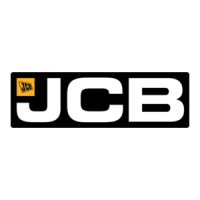45 - 6
Basic System Operation
Electrical Operation - Joystick Controller
There are two solenoid actuated isolation valves
incorporated in the servo pressure supply valve block, which
when energised direct servo pressure to enable the R.H. and
L.H. joystick controllers. Each valve solenoid is controlled by
proximity switches via a relay.
To make the joystick contollers active the seat must first be
locked in the forward or rear facing position, thereby closing
either the seat forward proximity switch Q or seat rear
proximity switch R. The operator must then raise forward the
arm rests. Raising the R.H. arm rest closes the R.H. arm
proximity switch P energising relay F and the R.H. isolation
valve solenoid H, making the R.H. joystick controller active.
Similarly the L.H. joystick controller is made active when the
L.H. arm rest is raised forward.
When an arm rest is pushed back by the operator, the
proximity switch in that arm rest will open and de-energise
the relay and solenoid, servo pressure will be isolated and
the joystick controller in that arm rest will be disabled.
Should the operator move the seat from the forward or rear
facing position, the appropriate proximity switch will open
and servo pressure to both joystick controllers will be
isolated, both joystick controllers will be disabled.
The L.H. joystick houses a horn switch S. On some machine
variants the joysticks also incorporate switches U and V for
control of a hydraulic quickhitch, and an auxiliary
changeover switch W, typically to select between jaw bucket
and extending dipper operation.
Component Key:
A Primary Fuse
B Relay
C Rear Horn Relay
D Auxiliary Changeover Relay
E Isolation Valve Relay - L.H. Joystick
F Isolation Valve Relay - R.H. Joystick
G Isolation Valve Solenoid - L.H. Joystick
H Isolation Valve Solenoid - R.H. Joystick
J Pump Dump Controller (Power Management ECU)
K Throttle Position Sensor
L Hydraulic Oil Temperature Sensor
M Unloader Valve (HSC) Solenoid
N Proximity Switch - L.H. Arm Rest
P Proximity Switch - R.H. Arm Rest
Q Proximity Switch - Seat Forward
R Proximity Switch - Seat Rear
S Rear Horn Switch
T Rear Horn Switch
U Quickhitch Switch
V Quickhitch Switch
W Auxiliary Change-over Switch
SA Splice
Pump Dump Controller (Power Management ECU)
The electronic control unit is mounted in the engine
compartment and is used to control engine hydraulic power.
When operating under conditions of high engine load and/or
conditions of high hydraulic oil temperature (when operating
hammer attachments for example), the pump dump
controller J automatically activates the unloading valve (HSC)
circuit, dumping the hydraulic oil flow from the secondary
pump section (P2) to tank.
1 Engine Load Condition:
The pump dump controller J compares the ‘actual’ engine
speed signal from the alternator stator with the engine speed
‘demanded’ signal from the throttle position sensor K.
If the engine speed should start to slow under conditions of
high load, the pump dump controller J energises the
unloader valve (HSC) solenoid M and illuminates an LED on
the side console. The flow from the secondary pump section
(P2) is dumped to tank reducing the flow available to the
hydraulic system, thereby reducing the load on the engine.
When the engine speed recovers the pump dump controller
de-energises the unloader valve (HSC) solenoid
(extinguishing the LED on the side console), enabling the
hydraulic system to operate normally.
The operating parameters are as follows:
a At engine speeds below 1000 rpm, as determined by
the throttle position sensor, the unloader valve (HSC)
solenoid will always be energised.
b At 1000 rpm the unloader valve (HSC) solenoid will be
energised if the engine rpm falls more than 150 rpm
below the ‘no load’ engine speed as determined by the
throttle position sensor. The unloader valve (HSC)
solenoid will de-energise when the engine rpm recovers
to less than 25 rpm below the ‘no load’ engine speed as
determined by the throttle position sensor.
c At engine speeds greater than 1000 rpm, the unloader
valve (HSC) solenoid energise and de-energise set
points are increased by 10 rpm for every 100 rpm
increase in engine speed.
2 Hydraulic Oil Temperature Condition:
The pump dump controller J monitors the hydraulic oil
temperature via a sensor L fitted at the rear of the hydraulic
oil tank.
If the oil temperature should reach 90°C, the pump dump
controller J energises the unloader valve (HSC) solenoid M
and illuminates an LED on the side console. The flow from
the secondary pump section (P2) is dumped to tank reducing
the flow available to the hydraulic system. The pump
continues to circulate the oil around the neutral circuit and
through the oil cooler until the oil temperature has reduced
sufficiently. When the oil temperature has fallen to less than
70°C, the pump dump controller de-energises the unloader
valve (HSC) solenoid (extinguishing the LED on the side
console), enabling the hydraulic system to operate normally.
Section D Controls
9803/3280
Section D
45 - 6
Issue 1
Precision Control (Servo)

